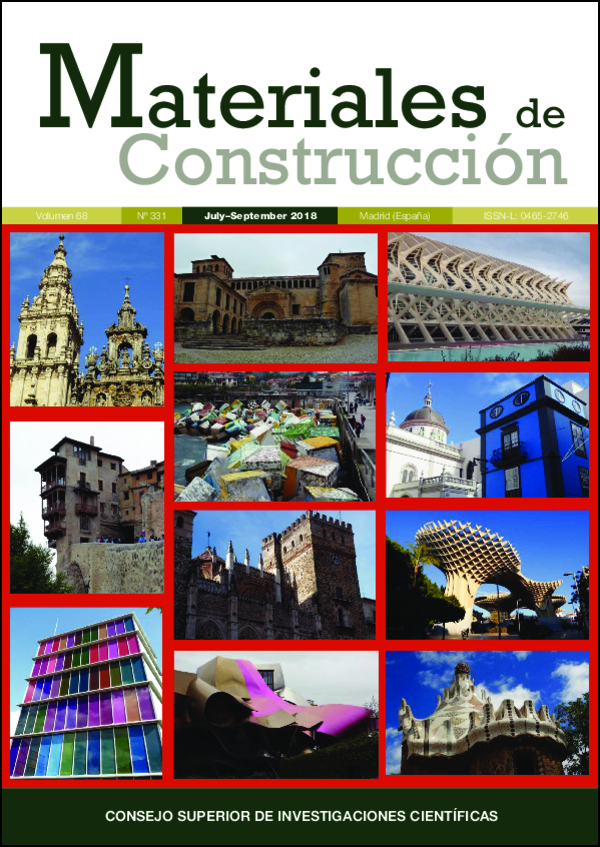Membranas sintéticas impermeables y capas auxiliares separadoras en la cubierta plana invertida. Efecto de la presión sobre la degradación
DOI:
https://doi.org/10.3989/mc.2018.07617Palabras clave:
Polímero, Cubierta plana invertida, durabilidad, membrana sintética impermeable, membrana monocapaResumen
Las cubiertas planas son invertidas cuando el material aislante se coloca sobre la membrana impermeable. Este sistema constructivo ampliamente utilizado emplea materiales que pueden interactuar con facilidad entre ellos, produciendo deterioro. Las incompatibilidades y los materiales que pueden interactuar no se han descrito completamente, los elementos utilizados actualmente para separar los materiales no son totalmente eficientes para evitar el deterioro. Este artículo pretende aumentar el conocimiento acerca de que materiales son incompatibles en la cubierta invertida plana, las condiciones para que las interacciones se den, y la eficiencia de algunas alternativas para separar materiales. Las membranas impermeables de etileno propileno monómero dieno (EPDM) son incompatibles con el poliestireno extrusionado (XPS). Las interacciones entre materiales incompatibles aumentan con la presión.
Descargas
Citas
Pedrosa, A.; Río, M. del (2013) Rehabilitation of flat roofs, concepts, minoration of incompatibilities and interactions. International Conference on Construction Research. Vivienda, pasado, presente y futuro. Instituto de Ciencias de la Construcción Eduardo Torroja, Madrid, Spain, CSIC, 173. http://digital.csic.es/bitstream/10261/108575/1/ Abstracts_and_Proceedings_%20JORNADAS%202013. pdf.
Pedrosa, A.; Río, M. del; Fonseca, C. (2014) Interaction between plasticized polyvinyl chloride waterproofing membrane and extruded polystyrene board, in the inverted flat roof. Mater. Construcc. 64 [316].
Buckley, D. J. (1967) Aspects of polymer compatibility. Transactions of the New York Academy of Sciences, 29: 735–747. https://doi.org/10.1111/j.2164-0947.1967.tb02297.x
Wilkes, C..E.; Summers, J.W.; Daniels, C.A.; Berard, M.T. (2005) PVC Handbook, Hanser Publishers, Munich, ISBNs 9781569903797 http://www.hanserpublications. com/Products/205-pvc-handbook.aspx
ASTM D883-12e1. (2012) Standard Terminology Relating to Plastics, ASTM International, West Conshohocken, PA, 2012, www.astm.org; Developed by Subcommittee: D20.92; Book of Standards Volume: 08.01;
Pedersen, G.A.; Jensen, L.K.; Fankhauser, A.; Biedermann, S.; Petersen, J.H.; Fabech, B. (2008) Migration of epoxidized soybean oil (ESBO) and phthalates from twist closures into food and enforcement of the overall migration limit. Part A: Chemistry, Analysis, Control, Exposure & Risk Assessment Food Additives & Contaminants, 25, 503–510. https://doi.org/10.1080/02652030701519088 PMid:18348048
Papakonstantinou, V.; Papaspyrides, C.D. (1994) Plasticizer migration from plasticized into unplasticized poly (vinyl chloride). J. Vinyl Technology, 16, [4192–196].
Marcilla, A.; Garcia, S.; Garcia-Quesada, J.C. (2008) Migrability of PVC plasticizers. Polymer Testing, 27. 221– 233, ISSN 0142-9418 Chemical Engineering Department, University of Alicante.
Pedrosa, A.; Río, M. del (2017) Comparative scanning electron microscope study of the degradation of a plasticized polyvinyl chloride waterproofing membrane in different conditions. Mater. Construcc. 67 [325] e109. https://doi.org/10.3989/mc.2017.08915
Giroud, J.P. (1995) Evaluation of PVC geomembrane shrinkage due to plasticizer loss. Geosynthetics International Industrial Fabrics Association International, 2 [6], 1099–1113.
Green, M. M.; Wittcoff, H.A. (2003). Organic Chemistry Principles and Industrial Practice. Weinheim. Germany: Wiley-VCH Verlag GmbH, p. 170. PMid:12909438
ASTM D1418-17 (2017) Standard Practice for Rubber and Rubber Latices—Nomenclature, ASTM International, West Conshohocken, PA, www.astm.org, https://www. astm.org/Standards/D1418.htm
Chandrasekaran, C. (2017) Anticorrosive Rubber Lining. A Practical Guide for Plastics Engineers. Elsevier. William Andrew applied science publisher. Oxford. United Kingdom. https://www.elsevier.com/books/ anticorrosive-rubber-lining/chandrasekaran/978-0-323- 44371-5.
Douglas, K. L. (2005). Elastomers. Handbook of sulphuric acid manufacturing. Richmond Hill, Canada: DKL Engineering, Inc. pp. 16–116, ISBN 9780973899207.
Bukhina, M.F.; Kurlyand, S.K. (2007) Low-Temperature Behaviour of Elastomers, New concepts in polymer science, CRC Press, Leiden - Boston, https://www.crcpress.com/Low-Temperature-Behaviour-of-Elastomers/Bukhina-Kurlyand/p/book/9789004157200 https://doi.org/10.1163/ej.9789004157200.i-188
Karpeles, R.; Grossi, A. V. (2001) "EPDM Rubber technology", Handbook of Elastomers, 2nd Ed., Anil K. Bhowmick and Howard L. Stephens [Editors], pp. 845–876, Marcel Decker, Inc., New York.
Beer, H. R.; Mayr A. (2008). Flexible Polyolefin Roofing Membranes: 15 Years Of Field. Experience. Durability of building materials and components 11: Proceedings of the Eleventh International Conference on Durability of Building Materials and Components, 11DBMC, Istanbul, Turkey, 11–14. Durability of systems and components in buildings & response of building elements to environmental loads, Vol 3.
Al-Ali AlMa´adeed, M.; I. Krupa, I. (2016). Polyolefin Compounds and Materials. Switzerland, Springer International Publishing, Springer Series on Polymer and Composite Materials, https://doi.org/10.1007/ 978-3- 319-25982-6_2. https://doi.org/10.1007/978-3-319-25982-6
Tolinski, M. (2015) Additives for Polyolefins. Getting the Most Out of Polypropylene, Polyethylene and TPO. Elsevier - William Andrew Publishing, Oxford, PMid:25687544 PMCid:PMC4486006
Soares, J. B. P.; McKenna T. F. L. (2012) Polyolefin Reaction Engineering. Wiley-VCH Verlag GmbH & Co. KGaA. Weinheim, Germany. https://doi.org/10.1002/9783527646944
Karian, H.G. (2003) Handbook of Polypropylene and Polypropylene Composites, RhTech, INC, Whitmore Lake, Michigan, USA, Marcel Dekker, New York, CRC Press. https://doi.org/10.1201/9780203911808
Ortega, J.J.; Blanco, M.; Cuevas, A. (1984) Acción de las radiaciones U.V. sobre el poli (cloruro de vinilo) flexible. Mater. Construcc. 196, [34].
ISO 177 (2016) Plastics - Determination of migration of plasticizers. International Organization for Standardization. Technical Committee ISO/TC 61/SC 6. Ageing, chemical and environmental resistance, ICS: 83.080.01 Plastics in general. https://www.iso.org/standard/70279.html.
UNE 104416 (2009). Synthetic materials. Waterproofing roofing systems made of membranes with flexible synthetic sheets. Instructions, control, use and maintenance. ICS 91.100.50-20 / Materiales sintéticos. AEN/CTN 104 – Materiales impermeabilizantes para la construcción. http:// webpre.aenor.com/normas-y-libros/buscador-de-normas/ une/?c=N0042729
ASTM D2103-15. (2015) Standard Specification for Polyethylene Film and Sheeting, ASTM International, West Conshohocken, PA, Book of Standards Volume: 08.01. http://www.astm.org/cgi-bin/resolver.cgi?D2103-15.
Su, X.; Song, J.; Qiu, Z-L.; Ru, H. (2012) The Temperature Impact on Migration of Four Kinds of Plasticizer in Food Packaging PVC Materials. Food Research and Development, Issue 1, Page 190–192. Food Science College, Shenyang Agriculture University, Shenyang Liaoning, China. http://en.cnki.com.cn/Article_en/CJFDTOTAL-SPYK201201052.htm
Publicado
Cómo citar
Número
Sección
Licencia
Derechos de autor 2018 Consejo Superior de Investigaciones Científicas (CSIC)

Esta obra está bajo una licencia internacional Creative Commons Atribución 4.0.
© CSIC. Los originales publicados en las ediciones impresa y electrónica de esta Revista son propiedad del Consejo Superior de Investigaciones Científicas, siendo necesario citar la procedencia en cualquier reproducción parcial o total.
Salvo indicación contraria, todos los contenidos de la edición electrónica se distribuyen bajo una licencia de uso y distribución “Creative Commons Reconocimiento 4.0 Internacional ” (CC BY 4.0). Consulte la versión informativa y el texto legal de la licencia. Esta circunstancia ha de hacerse constar expresamente de esta forma cuando sea necesario.
No se autoriza el depósito en repositorios, páginas web personales o similares de cualquier otra versión distinta a la publicada por el editor.
















